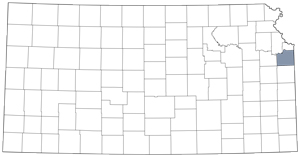Overland Park Arboretum and Botanical Gardens
The 300-acre Overland Park Arboretum and Botanical Gardens in Johnson County encompasses several miles of mulched walking trails winding through wooded hills and valleys as well as manicured parkland and gardens.
The trails provide a close-up look at Pennsylvanian-age limestone outcrops and younger alluvial fill—silt, sand, and other sediment—along Wolf Creek. The limestone formed from sediment deposited in shallow seas during the Pennsylvanian subperiod, which lasted from about 323 million to 299 million years ago. The Quaternary-age alluvial fill was eroded off outcrops and then carried in and deposited by flowing water in the river bed—a process that continues today.
All, or at least most, of the limestone along the trails is Wyandotte Limestone, a thick layer that got its name because it was first studied and described by a geologist in nearby Wyandotte County. The Wyandotte Limestone, a geologic unit called a formation, is divided into smaller units (layers) called members. Although it is known as the Wyandotte Limestone, its members are layers of limestone and shale (but mostly limestone). The shale layers, if present in the outcrops, are not easily seen. They may, in fact, only be present below Earth's surface there.
Although limestone layers may contain marine fossils, most often shells, not many can be easily found in the rocks at the Overland Park Arboretum. The best place to look for them along the trails is on the freshly broken (lighter-colored) surfaces of pieces broken off the outcrops. Likely finds would include broken shell fragments or algae, which would appear as raised lines. Fossils are more common in slightly younger limestones found farther west in Johnson County. Those younger layers once covered the arboretum area but were eroded away long ago, exposing the Wyandotte Limestone.
There is a small entrance fee for the Overland Park Arboretum and Botanical Gardens, which is open year round.
Johnson County
